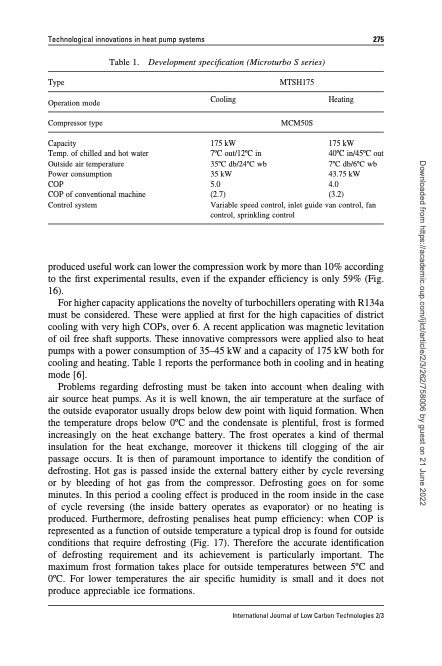
PDF Publication Title:
Text from PDF Page: 014
Technological innovations in heat pump systems 275 Table 1. Capacity Temp. of chilled and hot water Outside air temperature Power consumption COP COP of conventional machine Control system Development specification (Microturbo S series) Type Operation mode Compressor type Cooling MTSH175 MCM50S Heating 175 kW 7oC out/12oC in 35oC db/24oC wb 35 kW 5.0 (2.7) Variable speed control, inlet guide van control, fan control, sprinkling control produced useful work can lower the compression work by more than 10% according to the first experimental results, even if the expander efficiency is only 59% (Fig. 16). For higher capacity applications the novelty of turbochillers operating with R134a must be considered. These were applied at first for the high capacities of district cooling with very high COPs, over 6. A recent application was magnetic levitation of oil free shaft supports. These innovative compressors were applied also to heat pumps with a power consumption of 35–45 kW and a capacity of 175 kW both for cooling and heating. Table 1 reports the performance both in cooling and in heating mode [6]. Problems regarding defrosting must be taken into account when dealing with air source heat pumps. As it is well known, the air temperature at the surface of the outside evaporator usually drops below dew point with liquid formation. When the temperature drops below 0oC and the condensate is plentiful, frost is formed increasingly on the heat exchange battery. The frost operates a kind of thermal insulation for the heat exchange, moreover it thickens till clogging of the air passage occurs. It is then of paramount importance to identify the condition of defrosting. Hot gas is passed inside the external battery either by cycle reversing or by bleeding of hot gas from the compressor. Defrosting goes on for some minutes. In this period a cooling effect is produced in the room inside in the case of cycle reversing (the inside battery operates as evaporator) or no heating is produced. Furthermore, defrosting penalises heat pump efficiency: when COP is represented as a function of outside temperature a typical drop is found for outside conditions that require defrosting (Fig. 17). Therefore the accurate identification of defrosting requirement and its achievement is particularly important. The maximum frost formation takes place for outside temperatures between 5oC and 0oC. For lower temperatures the air specific humidity is small and it does not produce appreciable ice formations. 175 kW 40oC in/45oC out 7oC db/6oC wb 43.75 kW 4.0 (3.2) International Journal of Low Carbon Technologies 2/3 Downloaded from https://academic.oup.com/ijlct/article/2/3/262/758006 by guest on 21 June 2022PDF Image | Technological innovations in heat pump systems

PDF Search Title:
Technological innovations in heat pump systemsOriginal File Name Searched:
2-3-262.pdfDIY PDF Search: Google It | Yahoo | Bing
CO2 Organic Rankine Cycle Experimenter Platform The supercritical CO2 phase change system is both a heat pump and organic rankine cycle which can be used for those purposes and as a supercritical extractor for advanced subcritical and supercritical extraction technology. Uses include producing nanoparticles, precious metal CO2 extraction, lithium battery recycling, and other applications... More Info
Heat Pumps CO2 ORC Heat Pump System Platform More Info
| CONTACT TEL: 608-238-6001 Email: greg@infinityturbine.com | RSS | AMP |